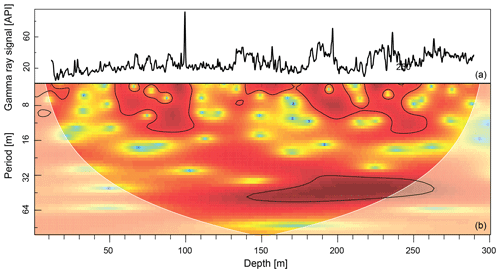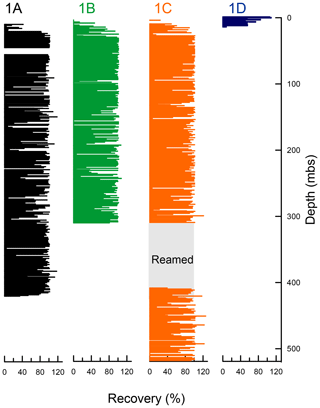Scientific drilling of Lake Chalco, Basin of Mexico (MexiDrill)
Margarita Caballero
Enrique Cabral Cano
Peter J. Fawcett
Socorro Lozano-García
Beatriz Ortega
Liseth Pérez
Antje Schwalb
Victoria Smith
Byron A. Steinman
Mona Stockhecke
Blas Valero-Garcés
Sebastian Watt
Nigel J. Wattrus
Josef P. Werne
Thomas Wonik
Amy E. Myrbo
Anders J. Noren
Ryan O'Grady
Douglas Schnurrenberger
the MexiDrill Team
The primary scientific objective of MexiDrill, the Basin of Mexico Drilling Program, is development of a continuous, high-resolution ∼400 kyr lacustrine record of tropical North American environmental change. The field location, in the densely populated, water-stressed Mexico City region gives this record particular societal relevance. A detailed paleoclimate reconstruction from central Mexico will enhance our understanding of long-term natural climate variability in the North American tropics and its relationship with changes at higher latitudes. The site lies at the northern margin of the Intertropical Convergence Zone (ITCZ), where modern precipitation amounts are influenced by sea surface temperatures in the Pacific and Atlantic basins. During the Last Glacial Maximum (LGM), more winter precipitation at the site is hypothesized to have been a consequence of a southward displacement of the mid-latitude westerlies. It thus represents a key spatial node for understanding large-scale hydrological variability of tropical and subtropical North America and is at an altitude (2240 m a.s.l.), typical of much of western North America. In addition, its sediments contain a rich record of pre-Holocene volcanic history; knowledge of the magnitude and frequency relationships of the area's explosive volcanic eruptions will improve capacity for risk assessment of future activity. Explosive eruption deposits will also be used to provide the backbone of a robust chronology necessary for full exploitation of the paleoclimate record. Here we report initial results from, and outreach activities of, the 2016 coring campaign.
- Article
(18147 KB) - Full-text XML
- BibTeX
- EndNote
Much is being written about climate change and the impact of rising seas on waterfront populations. But coasts are not the only places affected. Mexico City – high in the mountains, in the center of the country – is a glaring example.
“Mexico City, Parched and Sinking, Faces a Water Crisis” by Michael Kimmelman, The New York Times, 17 February 2017.
Understanding causal mechanisms of past rapid global climate change is a key problem in paleoclimate research, critical for evaluating impacts of ongoing and future trends. In particular, the role of the tropics in climate shifts remains poorly understood; the interplay of extratropical conditions, including interhemispheric temperature gradients, with tropical climate change remains an area of ongoing research (Chiang, 2009; Chiang and Friedman, 2012; Abram et al., 2016). To evaluate the role of low latitudes in initiating and propagating (or responding to) global changes, we need information regarding the geographic distribution and timing of abrupt changes in the tropics, including records that help characterize Intertropical Convergence Zone (ITCZ) variability. The MexiDrill program's objectives include obtaining records of temperature and precipitation/evaporation variability and the response of terrestrial vegetation as well as aquatic flora and fauna to these changes to examine climate and ecosystem evolution on millennial to Milankovitch timescales. The field location is adjacent to Mexico City, one of the world's greatest population centers, which is vulnerable to changing hydrological balance. It is dependent on groundwater withdrawal for municipal use – this has led to significant ongoing subsidence – while also suffering from surface flooding.
The Mexico City region is subject to a range of volcanic hazards (e.g., Arce et al., 2005, 2013; Siebe et al., 2006, 2017), so the long archive of volcanic eruptions gives this record particular societal relevance. Explosive eruption deposits will be used to provide the backbone of a robust chronology necessary for full exploitation of the Chalco paleoclimate record. Current knowledge of pre-Holocene volcanic activity in the region is poor, and the new chronological work will also allow determination of the relationships between magnitude and frequency of explosive volcanic eruptions, providing a framework for risk assessment of future activity. The length of the Chalco sediment record provides a unique archive of regional volcanism: current knowledge of explosive eruptions is limited by sparse subaerial exposures and is non-existent beyond the latest Pleistocene. The new record will enable us to assess frequency patterns across the spectrum of regional volcanic hazards by drawing on a much longer and higher-resolution record of past activity. It will also enable us to evaluate how the region's stratovolcanoes, including Toluca and Popocatepetl, developed through time, and will provide insights into how the nature and long-term frequency of mafic eruptions in the Chichinautzin volcanic field (cf. Arce et al., 2013) have developed through time.
The Chalco sediment record will enable us to examine climate change, especially in hydrologic balance, on multiple timescales, including the following.
- i.
Glacial–interglacial variation in moisture balance. Prior studies of regional lake records suggest an influence of westerlies at 19–17 ka, bringing winter precipitation and mitigating otherwise extremely dry conditions (Bradbury, 2000; Metcalfe et al., 2007; Correa-Metrio et al., 2012). Similarly, Vasquez-Selem and Heine (2011) noted glacial expansion at the Last Glacial Maximum (LGM), with an associated 6–7∘ temperature decrease. Vasquez-Selem and Heine (2011) suggest westerlies as the moisture source, which is consistent with findings of a reduced NAM during the LGM by Bhattacharya et al. (2017). We hypothesize that during glacial maxima the Laurentide Ice Sheet influenced westerlies and associated storm tracks to enhance moisture inputs to central Mexico, likely in combination with decreased evaporation associated with lower temperatures, analogous to LGM conditions.
- ii.
Variation of moisture balance among glacial periods. Preliminary diatom (e.g., presence of Stephanodiscus niagarae) and sedimentological evidence implies that during MIS 6, Lake Chalco was colder and fresher than during MIS 2, consistent with evidence that regional glaciation at MIS 6 was >50 % greater in areal extent than LGM glaciation (Vasquez-Selem and Heine, 2011). The new deep Chalco sediment cores will enable us to investigate whether earlier glacial periods (e.g., MIS 6, 8, and possibly 10) were wetter than the LGM and how much hydrologic variability there was between these different glacial periods.
- iii.
Precessional response. Precession-driven insolation in subtropical zones typically leads to greater precipitation at times of increased regional insolation. We hypothesize that Lake Chalco's response to precession was most pronounced during insolation maxima within warmer interglacials (e.g., MIS 5e vs. MIS 7c and e). We can also investigate whether insolation maxima during glacial periods were sufficient to draw the ITCZ further north, increasing precipitation in the Basin of Mexico (BoM).
- iv.
Millennial-scale response. The BoM is within a regional gradient in a millennial-scale climate, at times showing sensitivity to ITCZ migration (analogous to Lago Petén Itzá and the Cariaco Basin) and at other times responding to shifts in locations of westerlies (like the Santa Barbara Basin, Cave of the Bells, and Fort Stanton Cave). The MexiDrill core will provide opportunities to compare MIS 2–4 (hypothesized to be drier glacial periods) with MIS 6 and 8 (hypothesized to be wetter glacial periods) to examine the amplitude of millennial-scale events, how they are reflected in a range of proxies, and how millennial-scale variability is expressed at each of the terminations. We hypothesize that millennial-scale variability during glacial terminations was similar at Terminations I, II, and III, as suggested by the synthetic record of the Greenland climate (Barker et al., 2011).
- v.
Volcanic history. Volcaniclastic deposits in the Chalco core are likely to be dominated by tephra fall deposits, based on past research in the area (Ortega-Guerrero and Newton, 1998). Felsic deposits are likely to be derived predominantly from large explosive eruption deposits from the Nevado de Toluca and Popocatépetl stratovolcanoes, with several possible additional regional sources and mafic deposits from the monogenetic centers of the nearby Sierra Chichinautzin volcanic field. These tephra deposits can be used to explore the long-term development of these contrasting volcanic systems on 104–105-year timescales. By identifying sources of deposits throughout the core, we will establish whether systematic variation in eruption frequency or composition has characterized the growth of these volcanoes. Has activity in the Sierra Chichinautzin field been stable or episodic, and how does Holocene activity fit into this pattern? Is there cyclicity (or are there major shifts) in the pattern of explosive eruptions at Popocatépetl and Nevado de Toluca, and is this linked to currently recognized periods of edifice growth and destruction (cf. Siebe et al., 2017)?
1.1 Site description
The BoM (19∘30′ N, 99∘W; 9600 km2, 2240 m a.s.l.) is a hydrologically closed basin in the TransMexican Volcanic Belt (TMVB, Figs. 1–2). The emergence of the southern Chichinautzin volcanic field since 1.0 Ma (Arce et al., 2013) has been linked to closure of the basin and development of a lake system. Continued subsidence of this intermontane basin accommodated the accumulation of hundreds of meters of lacustrine sediments (Ortiz Zamora and Ortega Guerrero, 2010). Lake Chalco, the location of the MexiDrill site, was the southernmost of these lakes; its proximity to the volcanic peaks that contain the headwaters of streams feeding the lakes has made it the freshest of the lakes and likely the location of the most continuous sedimentation. Mexico City (then called Tenochtitlan) was established by the Aztecs in the 1300s on an island in the center of Lago de Texcoco (to the north of Chalco). In more recent times, the hydraulic regime of the BoM was heavily modified, lowering the water table to improve flood control, accommodate agricultural expansion, and provide water for urban development. The plain of Lake Chalco, located in the southeasternmost sub-basin of the BoM (Fig. 1), has an area of 120 km2 (Caballero and Ortega Guerrero, 1998), though the lake has been reduced to a shallow marshy remnant (Caballero Miranda, 1997).
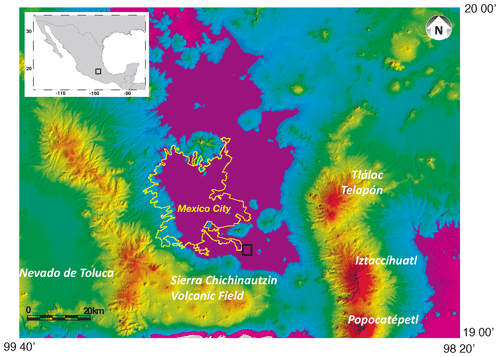
Figure 1Site map of the Basin of Mexico, showing the extent of the paleolake (flat magenta areas), the developed areas of the megalopolis, and locations of coring sites in Chalco (black box).
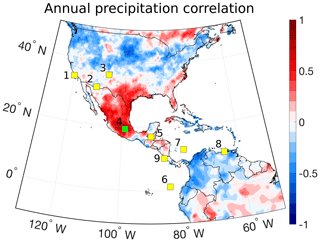
Figure 2Locations of long paleoclimate records from the northern tropics and subtropics of the Americas and correlation among regional precipitation patterns. 1. Santa Barbara Basin (ODP site 893); 2. Cave of the Bells, AZ; 3. Valles Caldera, NM; 4. Lake Chalco, Mexico; 5. Lago Petén Itzá, Guatemala; 6. Panama Basin (ODP 677B); 7. Nicaragua Rise (ODP 999A); 8. Cariaco Basin (ODP site 1002); 9. Terciopelo Cave, Costa Rica. Red and blue shading depicts the correlation (r) between annual precipitation at Chalco and all the other locations (1901–2013 CE; 10-year low-pass filter; 0.5∘ spatial resolution). The precipitation data are the mean of three gridded products: University of Delaware v5.01 (Willmott and Matsuura, 2001); Global Precipitation Climatology Center V7 (Schneider et al., 2016); and University of East Anglia CRU TS v. 4.03 (Harris et al., 2014).
An array of climate systems affects central and southern Mexico. Episodic northward surges of the ITCZ bring summer rains (Metcalfe et al., 2015). This circulation is distinct from that of the North American Monsoon (NAM). The BoM thus contrasts with northern Mexico and areas of the southwestern USA where the NAM delivers summer precipitation (greater than 60 % of the annual total) driven by land surface heating and convection on the high topography (Adams and Comrie, 1997). Modest winter season precipitation in central and southern Mexico is often associated with the southward penetration of mid-latitude frontal systems, locally known as “Nortes” (Reding, 1992; Pérez et al., 2014; Stahle et al., 2016).
Interannual variability of climate over Mexico is strongly influenced by ocean–atmosphere interactions, including the El Niño–Southern Oscillation (ENSO), the Atlantic Multidecadal Oscillation (AMO), and the Pacific Decadal Oscillation (PDO) (Magaña et al., 2003; Metcalfe et al., 2015; Stahle et al., 2016). Of all of these, ENSO has the strongest impact both in magnitude and stability of the teleconnection between sea surface temperatures and precipitation, but varies with both latitude and season. El Niño is associated with wet winters in the north but with drier summers over southern Mexico including the BoM (Magaña et al., 2003). The net result of these interactions is that modern precipitation in the BoM varies with northern Mexico and the southwestern USA on annual and interannual timescales, when ENSO and PDO have significant impacts. However, when a 20-year low-pass filter removes those influences, BoM precipitation is distinct from both regions (Fig. 2).
1.2 Prior work
The potential value of the Chalco Basin sediment archive has been recognized for decades (e.g., Sears and Clisby, 1952; Bradbury, 1989), and a number of previous studies demonstrated the sensitivity of the system to climate changes, particularly to regional hydrological balance. These studies primarily focused on the past 40 kyr, utilizing rock magnetism and pollen and diatom distributions to reconstruct paleoenvironmental conditions (Bradbury, 1989; Lozano García et al., 1993; Lozano García and Ortega Guerrero, 1994; Urrutia Fucugauchi et al., 1994, 1995; Lozano García and Xelhuantzi López, 1997; Caballero Miranda, 1997; Caballero and Ortega Guerrero, 1998). Broadly, these studies indicate that lake level was highest prior to 35 ka, shallowed from 30 to 22.5 ka, and deepened from 22.5 to 10 ka, with maximum post-LGM freshening between 14 and 10 ka. During the early Holocene, the lake became shallow and marshy (consistent with the general drying trend of central Mexico; Metcalfe et al., 2000). More recently, Lozano-García et al. (2015) identified millennial-scale rainfall variability in the Chalco Basin during MIS 3, observing that regional runoff was lower during the LGM than during deglaciation, which contrasts with some other regional records such as Lago Petén Itzá (Hodell et al., 2008). Torres-Rodríguez et al. (2015) developed an 85 kyr record of drought and related fire history recorded in Chalco sediments showing increased fire frequency during MIS 3 in association with higher spring insolation. Finally, Correa-Metrio et al. (2013) demonstrate that Chalco and Petén Itzá both have similar post-LGM rapid warming histories and that the velocity of climate change at that time was one-fourth that of the last 50 years.
2.1 Deep borehole surveys
Earlier characterization of deep BoM sediments was motivated by a need to understand the basin's structure for evaluation of seismic hazards and of groundwater resource sustainability. After the 1985 Mexico City earthquake, five deep (∼2 km) boreholes were drilled to characterize sediments and underlying volcanic sequences in the BoM, and to evaluate the Cretaceous carbonate basement. Analyses of well cuttings showed that the uppermost section, a lacustrine sequence of volcanic ash and sand intercalated with clays, is present across the BoM with a variable thickness up to 300 m. These surveys also indicated the presence of a deeper lacustrine sequence, 100–200 m in thickness, composed of gravels, clayey sands, and marls as well as granular volcanic material below an intervening volcanic unit (composed of Pliocene and Quaternary tuffs, lavas, and conglomerates). This lower sequence forms the Chalco Aquifer (Krivochieva and Chouteau, 2003). The survey found the thickest sedimentary pile at the Tulyehualco-1 borehole, located at the western end of the Chalco Basin, leading subsequent researchers to target that locale for further study.
2.2 Geophysical surveys for drill site selection
Seismic reflection surveys are a commonly used approach for selecting a drill site location with a long undisturbed record of continuous deposition. In lacustrine or marine conditions, acquisition of suitable seismic reflection data is a relatively straightforward exercise. Depending upon the depth of the target, suitable images of the sedimentary section can be easily achieved using either single-channel or multi-channel marine seismic surveying techniques. Collecting multi-channel seismic reflection data on land is far more challenging. Unlike the marine environment where the source and receivers are deployed in a relatively homogenous medium (the water column), on land the near-surface material is typically heterogeneous, often significantly negatively impacting the propagation of seismic energy.
In the Chalco sub-basin, the near-surface conditions have been severely impacted by the intensive agricultural development of the area. This resulted in significant reworking and amendment of unconsolidated near-surface soils and sediment. As a consequence it is difficult for surface-deployed seismic sources to couple sufficient energy into the underlying sediments to collect any meaningful seismic reflection data. Under such conditions, collection of high-quality seismic reflection data would require that the source (and possibly the geophones) be buried below the disturbed near-surface. Alternatively, Vibroseis vibrator trucks could inject energy into the underlying basin to produce meaningful reflections. Collecting the survey using either of these approaches would not have been feasible, as they would have entailed a field cost comparable to that of the actual drilling program.
We undertook a seismic reflection survey in 2011, with a strategy of using a Mini-Sosie source composed of an array of earth compactors to generate a randomly swept signal that could be processed in a similar fashion to Vibroseis surveys. However, once this survey was initiated it became apparent that the source was not capable of generating sufficient energy to pass through the unconsolidated and disturbed upper sections of Chalco sediments and produce meaningful reflections. Ultimately, the survey was acquired using a PEG-40 source, which generates seismic energy by striking a metal plate with an accelerated mass. The shot records produced by this source were significantly better than those generated by the Mini-Sosie, but still yielded few reflections and did not produce satisfactory survey results.
2.3 Other geophysical techniques
The inherent difficulty in utilizing standard seismic reflection techniques in this setting led us to employ a suite of non-traditional geophysical techniques to build a consistent picture of sediment thicknesses across the Chalco Basin. These techniques – subsidence mapping, gravity surveys, and passive seismic surveys – do not provide information on continuity of sedimentation or the presence of faults offsetting the sediments, but provided a consistent body of evidence that indicated a maximum sediment thickness of ∼300 m at the identified drilling location. In addition, transient electromagnetic (TEM) and magnetotelluric (MT) soundings undertaken at the time of the 2016 drilling campaign (Bücker et al., 2017) provide similar conclusions.
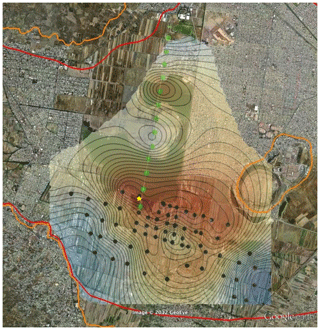
Figure 3Thickness of the lacustrine sedimentary package below the Chalco sub-basin calculated from resonance frequencies determined from H∕V spectral ratios. Red and orange lines represent contacts between the lacustrine and transitional geotechnical zones and between the transitional and the hillslope geotechnical zones, respectively (Gobierno del Distrito Federal, 2004). Water wells with known sediment thicknesses (Ortiz Zamora and Ortega Guerrero, 2010; green dots) were used as calibration points for individual passive seismic measurements (white dots). The color scale (blue–white–red) represents thicknesses of 0 (blue) to more than 300 (red) meters. The contour interval is 10 m. The selected drill site (yellow star) was where this survey indicated the thickest sediment pile, just to the south of the existing lake. © 2012 GeoEye and © Google Earth.
-
Subsidence mapping. Since the 1950s several areas of Mexico City, including the Chalco sub-basin, have experienced notable surface subsidence resulting from groundwater withdrawal for municipal needs that has caused the water table to drop. Subsidence rates are broadly correlative with the thickness of lacustrine sediment sequences and may thus be used to evaluate relative depth to basement across the basin. Combined interferometric synthetic aperture radar (InSAR) and GPS data reveal that parts of Mexico City have experienced subsidence rates that exceed 350 mm yr−1 (Cabral Cano et al., 2008, 2010). In the Chalco sub-basin these rates exceed 200 mm yr−1 and indicate maximal sediment thickness near the center of the basin (Fig. 3).
-
Gravity surveys. Bouguer gravity anomaly maps produced by Enrique Cabral Cano (personal communication, 2014) as part of a recent reinterpretation of 1950s vintage regional gravity data from the Valley of Mexico (Hernández-Moedano and Grauel, 1954) suggest that the study area is underlain by more than 300 m of sediment that fill an E–W trough. This has been interpreted as a graben bounded on the north by the Sierra Santa Catarina and Cerro de la Estrella and to the south by a horst-shaped block composed of the Teuhtli and Xitle volcanoes (Campos-Enriquez et al., 1997).
-
Passive seismic H∕V spectral ratios. In conjunction with our 2011 seismic reflection survey, we undertook a passive seismic H∕V spectral ratio survey (Nogoshi and Igarashi, 1971; Nakamura, 1989) across the Chalco Basin. Three-component recordings of the ambient seismic wavefield were made at locations in the field area. The seismic response of the sediment pile illuminated by the seismic energy is not uniform; it resonates at specific frequencies that are tied to the seismic properties of the sediments and the thickness of the sediment pile. The ratio between the Fourier amplitude spectra of the horizontal (H) to vertical (V) components of the ambient noise vibrations recorded at a common location can be used to identify the resonance frequency of the sediment package below the observation point (SESAME, 2005). We developed a calibration function by recording resonance frequencies at a series of water wells where the depth to the base of the lacustrine sediment package was known. We then measured resonance at grid points across the basin to construct a map of sediment thickness (Fig. 3), which shows maximal thicknesses in the areas indicated by subsidence mapping and gravity anomalies.
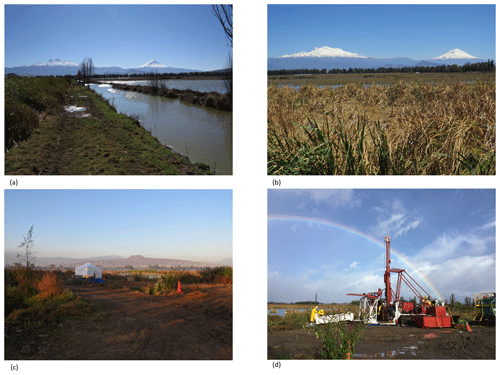
Figure 4Field images mosaic. Panels (a) and (b) are southeastward views from the field area showing the prominent stratovolcanoes Iztaccihuatl and Popcatépetl, which are, respectively, to the left and the right in these images. Panel (c) is a west-southwest view from the drill site looking toward Teuhtli volcano, one of the cones within the Sierra Chichinautzin volcanic field. Panel (d) is a northeasterly view of the Chalco Basin with the drill rig.
3.1 Drilling and onsite operations
During the 2016 ICDP Mexidrill drilling campaign, three long drill cores (1A, 1B, 1C; see Table 1) were retrieved in the Chalco Basin, recovering the entire lacustrine sequence (upper 300 m) and continuing into the volcanic basement, down to 522 m total depth (Fig. 7). A suitable drilling site was identified in the agricultural fields in the Tulyehualco district, near the depocenter of the lake basin. Drilling was performed by Major Drilling de Mexico S.A., using a truck-mounted Boart Longyear LF90 rig with standard Boart Longyear HQ3 wireline diamond coring tools (Fig. 4); 1.5 m long core sections of 61 mm diameter were collected in polycarbonate liners. HWT casing was advanced as needed to stabilize the formation during continued drilling, and later retrieved, and drill fluid returns were processed in a centrifuge to separate solids and allow recirculation. All drilling used municipal water delivered to the site, with a tracer added to allow post-drilling assessment of fluid contamination in the core samples (Friese et al., 2017). Drilling operations began on 23 February 2016 and concluded on 30 March 2016, in two daily shifts of 12 h each. To improve recovery in the uppermost soft sediments, an additional shallow fourth hole (1D) was cored by hand on 1–2 April 2016 with a Usinger-type percussion corer (Mingram et al., 2007), with cores extruded into secondary liners.
On retrieval, cores were extracted from the drilling tool, capped, sealed with tape, and labeled according to standard LacCore/CSDCO protocols. Drilling metadata were captured throughout operations and transferred to ICDP and to the LacCore Facility for integration with all project datasets. Cores were passed through a Geotek MSCL-S with a magnetic susceptibility loop sensor after drilling, for high-speed, low-resolution assessment of stratigraphic completeness. At the conclusion of drilling, cores were crated and shipped via air freight to the LacCore Facility at the University of Minnesota for processing, description, scanning, subsampling, and permanent curation in the LacCore repository in refrigerated conditions (4 ∘C).
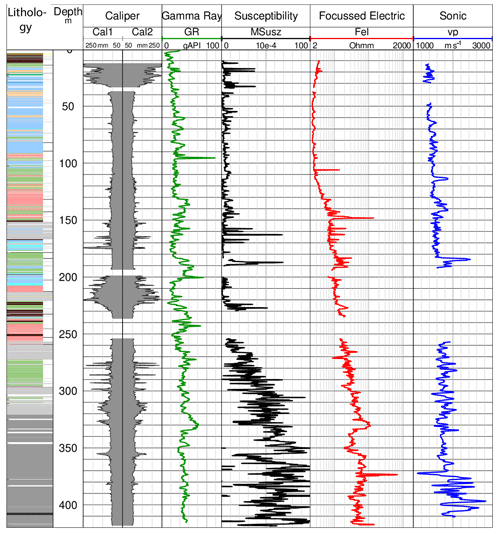
Figure 5Downhole logging data of the 1A borehole: Cal1 and Cal2 – caliper (in millimeters); GR – gamma ray; MSusz – microsusceptibility; Fel – focussed electric resistivity; vp – compressional velocity; lithology from core. Lithology legend in Fig. 8.
3.2 Downhole logging
The Leibniz Institute for Applied Geophysics (LIAG) conducted geophysical downhole logging in the 1A borehole. Initially, the upper section (0–195 m) was logged, and after drilling of the second part down to 420 m, the logging was completed to total depth. The following tools (measurements) were run: spectral gamma ray (SGR: total gamma ray; potassium, uranium, thorium), magnetic susceptibility (Susz: susceptibility with standard and micro resolution), focused electric resistivity (Fel), dipmeter (caliper and resistivity), acoustic borehole televiewer (borehole image), sonic (velocity vp), as well as salinity and temperature. All the instruments – except the SGR – require an open hole. Therefore, after measuring the SGR through the pipe over the complete depth, the drill string was pulled successively to guarantee the stability of the borehole, and the remaining tools were run. The first data processing step is to splice the data to produce a continuous log over full depth. Figure 5 shows some of the geophysical properties over the complete length (0–420 m) of the 1A borehole. Gaps within the logs were caused mostly by challenging borehole conditions. Gamma ray data show quasi-cyclic variations in different period ranges, possibly representing glacial–interglacial to sub-orbital climate variations (cycles). This is also depicted in a wavelet analysis plot (Fig. 6), showing that variability in the range below ∼10 m is quite consistent throughout the upper 300 m. In contrast, longer cycles are dominantly present in the lower interval from ∼150 to 300 m depth. The magnetic susceptibility responds primarily to volcanic material in this location. As a result, it is generally low above ∼250 m, with few spikes reflecting volcanic events (tephra layers or aquatic influx of volcanic material). The increase in resistivity and velocity reflects the higher degree of compaction with increasing depth.
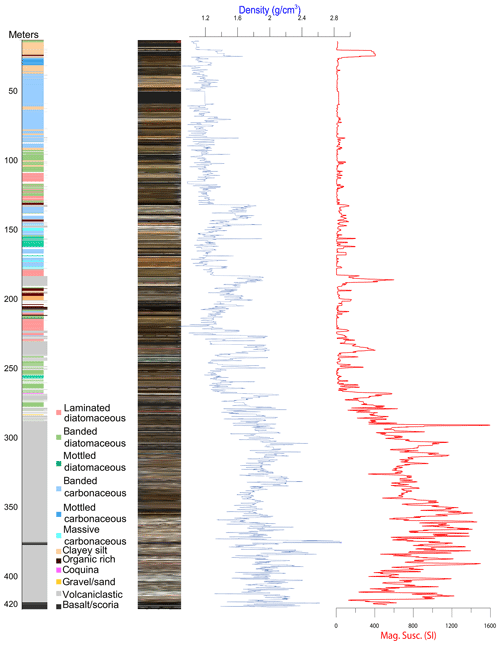
Figure 8Selected results from the initial core description of MEXI-CHA16-1A, including lithology, color, density, and magnetic susceptibility. The broad shifts from diatomaceous to carbonaceous sediments are possibly associated with glacial–interglacial cycles, with relatively wetter times associated with Northern Hemisphere glaciation.
Outreach and education efforts in conjunction with the MexiDrill program succeeded in making the project known to members of the general public and providing coring-related educational activities to primary and secondary school children. We developed a logo by providing input to an online design firm (https://thelogocompany.net/, last access: 20 January 2016); we use this logo consistently across presentations and social media and have made stickers to distribute in Mexico, the US, Spain, and Germany to participating institutions, outreach events, and scientific meetings. The project Facebook page has over 600 followers, two-thirds of whom are from Mexico. We also developed a custom field trip in both English and Spanish for the NSF-funded Flyover Country mobile app for geoscience (https://flyovercountry.io/, last access: 5 June 2019) that includes the drilling site, information about the goals and successes of the project, and numerous local geological attractions in the Chalco area. The sites on this field trip are discoverable by anyone using Flyover Country to investigate the Mexico City region; the app has over 200 000 downloads. In collaboration with a UNAM faculty member, Ane María Soler, we developed an engaging activity (“coring” layers of red polymer or gelatin) for local primary school students, along with a Spanish language presentation about the MexiDrill project; the activity and presentation have been used with hundreds of additional students in the time since the drilling took place. Finally, the project benefited tremendously by building on many years of discussions between the UNAM faculty (Caballero, Lozano, Ortega, and others) and community leaders of the ejidos, communal agricultural land that surrounded the drilling site.
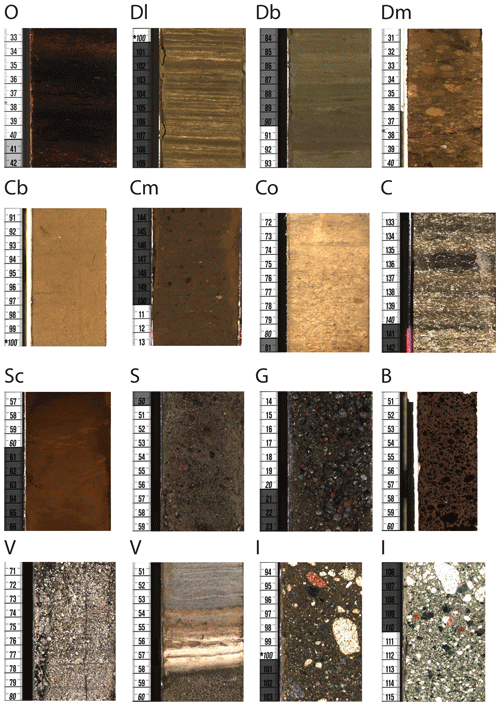
Figure 9Representative lithologies. These include organic-rich sediments (O; MEXI-CHA16-1A-76Y-1 32–42 cm) including organic-rich silty clays, sapropelic silty clays, and peat; diatomaceous silty clays, which may be laminated (Dl; MEXI-CHA16-1C-140Y-1 99–109 cm), banded (Db; MEXI-CHA16-1A-169Y-1 83–93 cm), and mottled (Dm; MEXI-CHA16-1D-10C-2 30–40 cm); calcareous silty clays, which may be banded (Cb; MEXI-CHA16-1D-11C-13 90–100 cm), mottled (Cm; MEXI-CHA16-1B-14Y-1-A 143–153 cm), or massive (Co; MEXI-CHA16-1C-174Y-1 132–142 cm); gastropod-dominated coquina (C; MEXI-CHA16-1C-174Y-1 132–142 cm); clastic sediments including silty clays (Sc; MEXI-CHA16- 1A-27Y-1-A 56–66 cm), sand (S; MEXI-CHA16-1C-178Y-1 49–59 cm), and gravel (G; MEXI-CHA16-1C-182Y-1 13–23 cm); basalt (B; MEXI-CHA16-1C-231Y-1 50–60 cm); volcaniclastic deposits including pyroclastic flows, lahars, and reworked volcanics (V; MEXI-CHA16-1B-181Y-1 70–80 cm and MEXI-CHA16-1B-177Y-1 50–60 cm); and igneous rock composed of massive cemented volcanic rocks (I; MEXI-CHA16-1A-269Y-1-A 93–103 cm and MEXI-CHA16-1A-271Y-1-A 105–115 cm).
Initial core description (ICD) was undertaken in the summer and fall of 2016. After whole-core multisensor logging (Geotek Multisensor Core Logger) for gamma density, acoustic wave velocity, electrical resistivity, loop-sensor magnetic susceptibility, and natural gamma cores were split lengthwise into work and archive halves. The core faces were cleaned for optical imaging, split-core multisensor logging with high-resolution point sensor magnetic susceptibility and color reflectance spectrophotometry, lithologic description of the archive half, and subsampling of the work half. Lithologic description included both visual core description (texture, bedding, color, structure, and other features) and petrographic smear slide and coarse fraction analysis for mineralogy and other microscopic constituents.
A splice (composite core) was developed from the four 2016 cores and portions of drill cores recovered through earlier shallow drilling campaigns in 2008 and 2011 at a site ∼450 m south-southwest of the 2016 drill site (Torres-Rodríguez et al., 2015; Herrera-Hernández, 2011). Metadata for the splice follow standard IODP protocols using splice and affine tables. An initial core stratigraphy was developed, and is summarized, along with logging data in Fig. 8.
Lithotypes were defined based on lithologies and textures determined by macroscopic examination and microscope smear slide observations. The broad range of depositional environments is reflected in the variety of lithotypes present in the core (Fig. 9).
The cores recovered by the MexiDrill project will provide information on the history of climate, environmental change, and volcanism over the past ∼400 kyr. In particular, the Chalco Basin is sensitive to changes in evaporation–precipitation balance that will provide key perspectives for evaluation of the impact of ongoing climate change on water resource availability in the Mexico City region.
Changes in hydrological balance are being evaluated using a combination of proxies based on sedimentology and sediment composition (e.g., carbonate preservation), pollen and diatom records, and the stable isotope composition of bulk OM, carbonates, diatom silica, and leaf waxes. XRF core scanning provides insights into carbonate deposition (Ca), diatom abundance (Si : Ti), and weathering intensity/sediment provenance (K : Ti). Variations in temperature will be examined through terrestrial and aquatic biomarkers in conjunction with pollen and microfossil records.
We will test the hypothesis that climate change drove the observed variations in glaciation by assessing the relative contribution of temperature (as measured by biomarkers) and precipitation (stable isotopes) to the change in glacial extent. An alternative hypothesis is that lake levels at Chalco responded to changes in basin morphology caused by volcanic activity (Siebe et al., 2017). For example, it is possible that MIS 2 appears less humid than MIS 6 and 8 in the Chalco record because topographic changes, associated with volcanism just north of Chalco (Sierra de Santa Caterina), decreased water flow from Chalco to the rest of the BoM lake system to the north and effectively made Chalco a closed-basin lake. We will evaluate this alternative by analyzing H isotopes in aquatic biomarkers to investigate potential shifts from open- to closed-basin hydrology (perhaps as a consequence of volcanic activity) and compare these results with broad-scale changes in precipitation inferred using H isotope analysis of terrestrial biomarkers, as well as through evidence from the volcanic deposits present in the core.
Extrapolation of radiocarbon-based sedimentation rates (Lozano-García et al., 2015) suggests that the Chalco record extends to MIS 9, which allows comparison of the regional response to precessional forcing during a warm interglacial (MIS 5e) with the response during cooler interglacials (MIS 7c and 7e). We will address this hypothesis using time series analysis of lake-level reconstruction and other proxies, including isotopes (biomarker δD, diatom δ18O, carbonate δ18O) and vegetation response (biomarker distributions and pollen abundance). If lake level/precipitation does not vary on precessional scales, it is difficult to argue that this pattern of greater precipitation during increased regional insolation would operate on a millennial scale. We will evaluate the relative influences of Northern Hemisphere ice sheets, insolation, and CO2 on precipitation in central Mexico using band pass filtering and spectral analysis of these proxy records.
Preliminary data outlined in this report are not publicly available as they are still being evaluated by the MexiDrill project team. Fully vetted datasets from the MexiDrill cores will be made available through LacCore, the National Lacustrine Core Repository, consistent with NSF and ICDP data sharing policies.
The archive and working halves of the MexiDrill (CHA16) cores are stored at LacCore (http://lrc.geo.umn.edu/laccore/repository.html; Noren, 2019).
Rodrigo Martínez Abarca (Instituto de Geología, Universidad Nacional Autónoma de México. Cd. de México, 04510, Mexico), Angeles Ortíz Beltrán (Instituto de Geofísica, Universidad Nacional Autónoma de México, Cd. de México, 04510, Mexico), Cecilia Caballero (Instituto de Geofísica, Universidad Nacional Autónoma de México, Cd. de México, 04510, Mexico), Laura Cappio (Large Lakes Observatory & Dept of Earth and Environmental Sciences, University of Minnesota Duluth, Duluth, MN 55812, USA), Rafael Cossio (Instituto de Geofísica, Universidad Nacional Autónoma de México, Cd. de México, 04510, Mexico), Troy Ferland (Department of Geology and Environmental Science, University of Pittsburgh, Pittsburgh, PA 15260, USA; Department of Geosciences, Pennsylvania State University, University Park, PA 16802, USA), Katja Hesse (Leibniz Institute of Applied Geophysics, Stilleweg 2, 30655 Hannover, Germany), Jens Kallmeyer (Deutsches GeoForschungsZentrum, Helmholtz-Zentrum Potsdam, Geomikrobiologie, 14473 Potsdam, Germany), Dervla Kumar (Department of Geology and Environmental Science, University of Pittsburgh, Pittsburgh, PA 15260, USA; Department of Geosciences, University of Arizona, Tucson, AZ 85719, USA), Sandra García Leon (Instituto de Geofísica, Universidad Nacional Autónoma de México, Cd. de México, 04510, Mexico), Ivan Martínez (Instituto de Geofísica, Universidad Nacional Autónoma de México, Cd. de México, 04510, Mexico), Carmen Acosta Noriega (Instituto de Geología, Universidad Nacional Autónoma de México. Cd. de México, 04510, Mexico), Frank Preusser (Institut für Geo- und Umweltnaturwissenschaften, Albert-Ludwigs-Universität Freiburg, 79104, Freiburg, Germany), Harriet Rawson (Department of Earth Sciences, University of Oxford, OX1 3AN, Oxford, UK), Ana María Soler (Instituto de Geofísica, Universidad Nacional Autónoma de México, Cd. de México, 04510, Mexico), Susana Sosa-Nájera (Instituto de Geología, Universidad Nacional Autónoma de México. Cd. de México, 04510, Mexico), Diana Avendaño Villeda (Instituto de Geofísica, Universidad Nacional Autónoma de México, Cd. de México, 04510, Mexico), and Christian Zeeden (Leibniz Institute of Applied Geophysics, Stilleweg 2, 30655 Hannover, Germany).
ETB, MC, ECC, PJF, SLG, BO, LP, AS, VS, BAS, MS, BVG, SW, NJW, JPW, TW, and AJN designed the research. ETB, MC, CC, PJF, SLG, BO, LP, AS, VS, BAS, AMS, MS, BVG, SW, NJW, JPW, TW, AEM, AJN, RO'G, and DS performed the research. ETB, MC, PJF, SLG, BO, LP, AS, VS, BAS, MS, BVG, SW, NJW, JPW, TW, CZ, and AJN analyzed the data. ETB, MC, PJF, SLG, BO, LP, AS, VS, BAS, MS, BVG, SW, NJW, JPW, TW, CZ, AEM, and AJN wrote the paper.
The authors declare that they have no conflict of interest.
Any opinions, findings, or conclusions of this study represent the views of the authors.
This research was supported by research funding from the US NSF, UNAM, ICDP, and the Swiss NSF. Mark Brenner's careful reading and thoughtful suggestions improved the manuscript.
This research has been supported by the ICDP (grant 2014/05), the US-NSF EAR (grant nos. 1803725, 1551311, 1804858, 1551429, and 1804429), the UNAM (grant nos. UNAM-DGAPA PAPIIT-IV100215 and IN103819), and the Swiss NSF (grant no. P300P2 158501).
This paper was edited by Ulrich Harms and reviewed by Mark Brenner and one anonymous referee.
Abram, N. J., McGregor, H. V., Tierney, J., Evans, M., McKay, N., Kaufman, D., and the PAGES 2k Consortium: Early onset of industrial-era warming across the oceans and continents, Nature, 536, 411–418, 2016.
Adams, D. K. and Comrie, A. C.: The North American Monsoon, B. Am. Meteorol. Soc., 78, 2197–2215, 1997.
Arce, J., Cervantes, K., Macias, J., and Mora, J.: The 12.1 ka Middle Toluca Pumice: a dacitic Plinian-subplinian eruption of Nevado de Toluca in Central Mexico, J. Volcanol. Geoth. Res., 147, 125–143, 2005.
Arce, J., Layer, P., Lassiter, J., Benowitz, J., Macias, J., and Ramirez-Espinosa, J.: 40Ar∕39Ar dating, geochemistry, and isotopic analyses of the quaternary Chichinautzin volcanic field, south of Mexico City: implications for timing, eruption rate, and distribution of volcanism, B. Volcanol., 75, 774, https://doi.org/10.1007/s00445-013-0774-6, 2013.
Barker, S., Knorr, G., Edwards, R. L., Parrenin, F., Putnam, A. E., Skinner, L. C., Wolff, E., and Ziegler, M.: 800 000 years of abrupt climate variability, Science, 334, 347–351, 2011.
Bhattacharya, T., Tierney, J., and DiNezio, P.: Glacial reduction of the North American Monsoon via surface cooling and atmospheric ventilation, Geophys. Res. Lett., 44, 5113–5122, 2017.
Bradbury, J. P.: Late Quaternary lacustrine paleoenvironments in the Cuenca de Mexico, Quaternary Sci. Rev., 8, 75–100, 1989.
Bradbury, J. P.: Limnologic history of Lago de Patzcuaro, Michoacan, Mexico for the past 48 000 years: impacts of climate and man, Palaeogeogr. Palaeocl., 163, 69–95, 2000.
Bücker, M., Lozano García, S., Ortega Guerrero, B., Caballero Miranda, M., Pérez, L., Caballero García, L., Pita de la Paz, C., Sánchez-Galindo, C., Villegas, F. J., Flores Orozco, A., Brown, E., Werne, J., Valero Garcés, B., Schwalb, A., Kemna, A., Sánchez-Alvaro, E., Launizar-Martínez, N., Valverde-Placencia, A., and Garay-Jiménez, F.: Geoelectrical and electromagnetic methods applied to paleolimnological studies: two examples from dessicated lakes in the basin of Mexico, Bol. Soc. Geol. Mex., 69, 279–298, 2017.
Caballero, M. and Ortega Guerrero, B.: Lake levels since about 40 000 years ago at lake Chalco, near Mexico City, Quaternary Res., 50, 69–79, 1998.
Caballero Miranda, M.: Reconstrucción paleolimnológica del Lago de Chalco durante el último máximo glaciar, el registro de diatomeas entre 34 000 y 15,000 años A.P., Rev. Mex. Cienc. Geol., 14, 91–100, 1997.
Cabral-Cano, E., Dixon, T., Miralles-Wilhelm, M., Sánchez-Zamora, O., Díaz-Molina, O., and Carande, R.: Space Geodetic Imaging of Rapid Ground Subsidence in México City, Geol. Soc. Am. Bull., 120, 1556–1566, https://doi.org/10.1130/B26001.1, 2008.
Cabral-Cano, E., Osmanoglu, B., Dixon, T., Wdowinski, S., DeMets, C., Cigna, F., and Díaz-Molina, O.: Subsidence and fault hazard maps using PSI and permanent GPS networks in central Mexico, in: IAHS-AISH Publication, 8th International Symposium on Land Subsidence, EISOLS, 17 October 2010, Santiago de Queretaro, Mexico, vol. 339, 255–259, 2010.
Campos-Enriquez, J. O., Delgado-Rodríguez, O., Chavez-Segura, R., Gomez-Contrera, P., Flores-Maruez, E. L., and Birch, F. S.: The subsurface structure of the Chalco sub-basin (Mexico City) inferred from geophysical data, Geophys., 62, 23–35, 1997.
Chiang, J. C. H.: The Tropics in Paleoclimate, Annu. Rev. Earth. Pl. Sc., 37, 263–297, 2009.
Chiang, J. C. H. and Friedman, A.: Extratropical Cooling, Interhemispheric Thermal Gradients, and Tropical Climate Change, Annu. Rev. Earth Pl. Sc., 40, 383–412, https://doi.org/10.1146/annurev-earth-042711-105545, 2012.
Correa-Metrio, A., Lozano-García, S., Xelhuantz-Lopez, S., Sosa-Najera, S., and Metcalfe, S. E.: Vegetation in western Central Mexico during the last 50 000 years: modern analogs and climate in the Zacapu Basin, J. Quaternary Sci., 27, 509–518, 2012.
Correa-Metrio, A., Bush, M., Lozano-García, S., and Sosa-Nájera, S.: Millennial-Scale Temperature Change Velocity in the Continental Northern Neotropics, PLoS ONE, 8, e81958, https://doi.org/10.1371/journal.pone.0081958, 2013.
Friese, A., Kallmeyer, J., Axel Kitte, J., Montaño Martínez, I., Bijaksana, S., and Wagner, D.: A simple and inexpensive technique for assessing contamination during drilling operations, Limnol. Oceanogr. Meth., 15, 200–211, https://doi.org/10.1002/lom3.10159, 2017.
Gobierno del Distrito Federal: Normas técnicas complementarias para diseño y construcción de cimentaciones. Gaceta Oficial del Distrito Federal, Mexico City, Mexico, 103–BIS, 11–39, 2004.
Gouhier, T., Grinsted, A., and Simko, V.: R package biwavelet: Conduct Univariate and Bivariate Wavelet Analyses (Version 0.20.17), available at: https://github.com/tgouhier/biwavelet (last access: 25 June 2019), 2018.
Harris, I., Jones, P., Osborn, T., and Lister, D.: Updated high-resolution grids of monthly climatic observations – the CRU TS3.10 Dataset, Int. J. Climatol., 34, 623–642, https://doi.org/10.1002/joc.3711, 2014.
Hernández-Moedano, G. and Grauel, M. D.: Levantamiento gravimetrico en el Valle de Mexico, Informe Technico para el INIC, Mexico City, Mexico, 30 pp., 1954.
Herrera-Hernández, D.: Estratigrafía y análisis de facies de los sedimentos lacustres del Cuaternario tardío de la cuenca de Chalco, México, MSc Thesis, Instituto de Geofísica, Universidad Nacional Autónoma de México, Mexico City, Mexico, 122 pp., 2011.
Hodell, D. A., Anselmetti, F. S., Ariztegui, D., Brenner, M., Curtis, J. H., Gilli, A., Grzesik, D. A., Guilderson, T. J., Müller, A. D., Bush, M. B., Correa-Metrio, A., Escobar, J., and Kutterolf, S.: An 85-ka record of climate change in lowland Central America, Quaternary Sci. Rev., 27, 1152–1165, 2008.
Kimmelman, M.: Mexico City, Parched and Sinking, Faces a Water Crisis, New York Times, 17 February 2017, New York City, USA, 2017.
Krivochieva, S. and Chouteau, M.: Integrating TDEM and MT methods for characterization and delineation of the Santa Catarina aquifer (Chalco Sub-Basin, Mexico), J. Appl. Geophys., 52, 23–43, 2003.
Lozano-García, M. S. and Ortega-Guerrero, B.: Palynological and magnetic susceptibility records of Lake Chalco, central Mexico, Palaeogeogr. Palaeocl., 109, 177–191, 1994.
Lozano-García, M. S. and Xelhuantzi-Lopez, M. S.: Some problems in the Late Quaternary pollen records of central Mexico basins of Mexico and Zacapu, Quatern. Int., 43, 117–123, 1997.
Lozano-García, M. S., Ortega-Guerrero, B., Caballero-Miranda, M., and Urrutia-Fucugauchi, J.: Late Pleistocene and Holocene Paleoenvironments of Chalco Lake, Central Mexico, Quaternary Res., 40, 332–342, 1993.
Lozano-García, M., Ortega, B., Roy, P., Beramendi-Orosco, L., and Caballero, M.: Climatic variability in the northern sector of the American tropics since the latest MIS 3, Quaternary Res., 84, 262–271, 2015.
Magaña, V. O., Vazquez, J. L., Pérez, J. L., and Pérez, J. B.: Impact of El Niño on precipitation in Mexico, Geofis. Int., 42, 313–330, 2003.
Metcalfe, S. E., O'Hara, S. L., Caballero, M., and Davies, S. J.: Records of Late Pleistocene-Holocene climatic change in Mexico – A review, Quaternary Sci. Rev., 19, 699–721, 2000.
Metcalfe, S. E., Davies, S. J., Braisby, J. D., Leng, M. J., Newton, A. J., and Terrett, N. L.: Long and short-term change in the Patzcuaro Basin, central Mexico, Palaeogeogr. Palaeocl., 247, 272–295, 2007.
Metcalfe, S. E., Barron, J. A., and Davies, S. J.: The Holocene history of the North American Monsoon: “known knowns” and “known unknowns” in understanding its spatial and temporal complexity, Quaternary Sci. Rev., 120, 1–27, 2015.
Mingram, J., Negendank, J. F., Brauer, A., Berger, D., Hendrich, A., Köhler, M., and Usinger, H.: Long cores from small lakes – recovering up to 100 m-long lake sediment sequences with a high-precision rod-operated piston corer (Usinger-corer), J. Paleolimnol., 37, 517–528, 2007.
Nakamura, Y.: A method for dynamic characteristics estimation of subsurface using microtremoron the ground surface, Quarterly Report of RTRI, 30, 25–30, 1989.
Nogoshi, M. and Igarashi, T.: On the amplitude characteristics of microtremor (part 2), J. Seismol. Soc. Jpn., 24, 26–40, 1971 (in Japanese with English abstract).
Noren, A.: LacCore, National Lacustrine Core Facility, available at: http://lrc.geo.umn.edu/laccore/repository.html, last access: 30 June 2019.
Ortega-Guerrero, B. and Newton, A.: Geochemical Characterization of Late Pleistocene and Holocene Tephra Layers from the Basin of Mexico, Central Mexico, Quaternary Res., 50, 90–106, https://doi.org/10.1006/qres.1998.1975, 1998.
Ortiz-Zamora, D. and Ortega-Guerrero, A.: Evolution of long-term land subsidence near Mexico City: Review, field investigations, and predictive simulations, Water Resour. Res., 46, W01513, https://doi.org/10.1029/2008WR007398, 2010.
Pérez, E. P., Magaña, V., Caetano, E., and Kusunoki, S.: Cold surge activity over the Gulf of Mexico in a warmer climate, Front. Earth Sci., 2, 19, https://doi.org/10.3389/feart.2014.00019, 2014.
Reding, P. J.: The central American cold surge: an observational analysis of the deep southward penetration of North American cold fronts, MS Thesis, Texas A&M University, College Station, TX, USA, 177 pp., 1992.
Schneider, U., Ziese, M., Meyer-Christoffer, A., Finger, P., Rustemeier, E., and Becker, A.: The new portfolio of global precipitation data products of the Global Precipitation Climatology Centre suitable to assess and quantify the global water cycle and resources, Proc. IAHS, 374, 29–34, https://doi.org/10.5194/piahs-374-29-2016, 2016.
Sears, P. B. and Clisby, K. H.: Two long climate records, Science, 116, 176–178, 1952.
SESAME: Guidelines for the implementation of the H/V spectral ratio technique on ambient vibrations measurements, processing and interpretation, SESAME European Research Project, Brussels, Belgium, Deliverable D23.12, 62 pp., 2005.
Siebe, C. and Macias, J. L.: Volcanic hazards in the Mexico City metropolitan area from eruptions at Popocatépetl, Nevado de Toluca, and Jocotitlan stratovolcanoes and monogenetic scoria cones in the Sierra Chichinautzin Volcanic Field, Geol. Soc. Am. Spec. Pap., 402, 253–329, 2006.
Siebe, C., Salinas, S., Arana-Salinas, L., Macias, J. L., Gardner, J., and Bonasia, R.: The ∼23 500 y 14C BP White Pumice eruption and associated debris avalanche and Tochimilco lava flow of Popocatepetl volcano, Mexico, J. Volcanol. Geoth. Res., 333–334, 66–95, https://doi.org/10.1016/j.jvolgeores.2017.01.011, 2017.
Stahle, D. W., Cook, E., Burnette, D., Villanueva, J., Cerano, J., Burns, J., Griffin, D., Cook, B., Acuna, R., Torbenson, M., Szejner, P., and Howard, I.: The Mexican Drought Atlas: Tree-ring reconstructions of the soil moisture balance during the late pre-Hispanic, colonial, and modern eras, Quaternary Sci. Rev., 149, 34–60, 2016.
Torres-Rodríguez, E., Lozano-García, S., Roy, P., Ortega, B., Beramendi-Orosco, L., Correa-Metrio, A., and Caballero, M.: Last Glacial droughts and fire regimes in the central Mexican highlands, J. Quaternary Sci., 30, 88–99, 2015.
Urrutia-Fucugauchi, J., Lozano, S., Ortega-Guerrero, B., Caballero, M., Böhnel, H., Hansen, R., and Negendank, J. F. W.: Paleomagnetic and paleoenvironmental studies in the southern basin of Mexico – I. Volcanosedimentary sequence and basin structure of Chalco Lake, Geofis. Int., 33, 421–444, 1994.
Urrutia Fucugauchi, J., Lozano García, S., Ortega Guerrero, B., and Caballero Miranda, M.: Paleomagnetic and paleoenvironmental studies in the southern basin of Mexico: II. Late Pleistocene-Holocene Chalco lacustrine record, Geofis. Int., 34, 33–53, 1995.
Vasquez-Selem, L. and Heine, K.: Late Quaternary Glaciation in Mexico, in: (Eds) Quaternary Glaciations – Extent and Chronology. A Closer Look, edited by: Elhers, J., Gibbard, P. L., and Hughes, P. D., Elsevier, Amsterdam, the Netherlands, 849–861, 2011.
Willmott, C. J. and Matsuura, K.: Terrestrial Air Temperature and Precipitation: Monthly and Annual Time Series (1950–1999), available at: http://climate.geog.udel.edu/~climate/html_pages/README.ghcn_ts2.html (last access: 15 June 2019), 2001.
- Abstract
- Introduction
- Site surveys
- Drilling, logging, and onsite operations
- Outreach and education
- Initial core description results
- Conclusions
- Data availability
- Sample availability
- Team list
- Author contributions
- Competing interests
- Disclaimer
- Acknowledgements
- Financial support
- Review statement
- References
- Abstract
- Introduction
- Site surveys
- Drilling, logging, and onsite operations
- Outreach and education
- Initial core description results
- Conclusions
- Data availability
- Sample availability
- Team list
- Author contributions
- Competing interests
- Disclaimer
- Acknowledgements
- Financial support
- Review statement
- References







